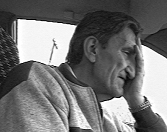
Self Deliverance 2001
Distributed by Fanlight Productions, 32 Court St., 21st Floor, Brooklyn, NY 11201; 800-876-1710
Produced by Michael Lutsky
Director n/a
VHS, color, 18 min.
Adult
Health Sciences, Bioethics, Law, Sociology
Date Entered: 11/09/2018
Reviewed by Charles J. Greenberg, Cushing/Whitney Medical Library, Yale UniversityFanlight Productions has released a short, concise documentary entitled Self Deliverance, a visual diary of Mr. John Graham’s quest for a dignified and self-determined end of life, based on his interaction with a morally ambivalent Australian health care system that sustains both his life and his suffering at the same time.
The painful structure of Mr. Graham’s daily existence is captured in short self-narrated vignettes of daily trips to the drug store for quantities of morphine to kill pain and several first person monologues on his pride in living independently. Despite a growing incapacity to travel and self-described constant pain, he neither bitter nor depressed and continues to manifest appreciation for those who play roles in relieving his suffering. He plays the piano to distract himself from his suffering. He also continues to be adamantly in favor of legal and ethical opportunity to determine the moment at which his life as we know it will cease.
The spare and stark visual black and white production qualities complement the political polarity of opinion on physician-assisted suicide, represented in the film by two independently interviewed doctors speaking with rational conviction both for and against the physician role in patient suicide. One of the physicians also narrates images and description of a “self-deliverance” computer program designed to present both conscious choice and self-administered lethal drug delivery, in effect eliminating the need for the presence of a physician to mediate the administration of a deadly dose.
Producer Lutsky, while attempting to present some amount of both sides in the societal dilemma, provides Mr. Graham with both the first and last word on individual conscience and choice. A postscript introduces the irony that Graham outlived not only the introduction of an Australian legal statute permitting physician-assisted suicide but also the subsequent judicial voiding of that law after less than a handful of successful cases of physician assistance.
Lutsky’s portrayal of Graham’s story had earlier reached a global public radio audience as an audio documentary A Matter of Life and Death: Assisted Suicide in Australia (Soundprint, August 18, 2000). Unlike a radio presentation, which leaves much to the imagination in terms of appearances, this particular documentary relies on careful editing and visual depiction of suffering to educate the audience and establish a point of view on the value of self determination at the end of life.
Because of the November 2001 U.S. controversy over federal objections to Oregon state law permitting physician-assisted suicide, an academic audience for international comparison may exist for the Australian controversy documented by Lutsky.
Recommended for academic collections in bioethics, law, and the sociology of death and dying.